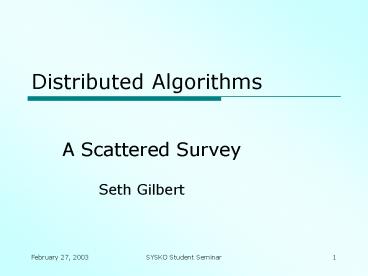Distributed Algorithms - PowerPoint PPT Presentation
1 / 36
Title:
Distributed Algorithms
Description:
Other building-block algorithms: Atomic Memory, Mutual Exclusion, Logical time / Synchronizers ... wait-free distributed implementation A' of algorithm A ... – PowerPoint PPT presentation
Number of Views:172
Avg rating:3.0/5.0
Title: Distributed Algorithms
1
Distributed Algorithms
- A Scattered Survey
- Seth Gilbert
2
Overview
- Introduction
- Models
- Algorithms
- Formal Methods
3
Introduction
- What is a distributed algorithm?
- Why study distributed algorithms?
- Is it practical?
- Examples
- TCP/IP, ethernet, Napster/Gnutella, NFS, Amazon
4
Model Basics
5
Model Basics - Anonymous
6
Model Basics Unique IDs
12
7
88
40
2
9
31
25
4
7
Model Basics - Network
12
7
88
40
2
9
9
31
25
4
8
Model Basics - Unidirectional
12
7
88
40
2
9
31
25
4
9
Model Basics - Ring
12
7
88
40
2
9
31
25
4
10
Model Basics Shared Memory
7
88
40
read/write
2
A
9
9
31
25
B
11
Synchronous Model
Network
i
j
time td
time t
Clock
12
Asynchronous Model
Network
i
j
time t???
time t
Clock
13
Partially Synchronous Models
- Many different models
- Good clocks / unbounded communication
- Eventually synchronous
- Some communication links good
- Failure Detectors
- Eventual notification of failures
14
Algorithms Overview
- Leader Election
- Shortest Path
- Consensus
- Other building-block algorithms
- Atomic Memory, Mutual Exclusion, Logical time /
Synchronizers - Note no randomization!!
15
1. Leader Election
- Assumptions
- Ring topology
- Synchronous network
- No failures
- Goal
- Exactly one process says, I am the leader
16
Leader Election Basics
- Impossible without unique IDs
- Symmetry
- Randomization helps
- Impossible with any failures
- ring topology
17
Basic Algorithm
- Send ID to the right
- Remember largest ID and resend
- Discard smaller IDs
- Time O(n) rounds
- Message complexity O(n2)
18
Better Algorithm
- Goal O(n log n) messages
- Add time-to-live to ID
- Proceed by levels
- TTL 2, TTL 4, TTL 8,
- log(n) rounds
- O(n) messages each round
- Optimal for comparison-based algorithms
19
Algorithms
- Basic
- Time O(n) rounds
- Message complexity O(n2)
- More Complicated
- Time O(n) rounds
- Message complexity O(n log n)
20
Lower Bounds Messages
- Comparison based algorithms
- O(n log n) messages
- In general
- O(n) messages
- Asynchronous Networks
- O(n log n)
21
2. Shortest Path Routes
- Input
- Connected, undirected graph
- Destination
- Output
- Shortest route to destination
- Model Self-Stabilizing
- Asynchronous
- Arbitrary failures! (e.g. corrupt state)
- Eventual stabilization
22
Bellman-Ford
- Every so often
- Ask all neighbors distance
- Set distance to minimum
- Destination always distance0
- Stabilizes after n rounds
23
3. Consensus
- Input
- 1 or 0 to each node
- Output
- Agreement all nodes decide either 0 or 1
- Termination all nodes eventually decide
- Validity if all inputs 1, then decide 1
24
Motivation
- Many problems equivalent to consensus
- Read-Modify-Write Memory
- Database commit
- Transactional filesystem
- Totally ordered broadcast
- Distributed firing squad
25
Universality Result
- Assume consensus service
- Assume non-fault tolerant sequential algorithm
(data object) A - Then
- There exists a faul-tolerant, wait-free
distributed implementation A of algorithm A
26
Asynchronous Consensus
- Assume 1 stopping failure
- Impossible! FLP 1985
- If consensus algorithm C guarantees agreement and
validity - Then
- There exists an execution of C that does not
terminate
27
More Consensus Models
- Synchronous
- f1 rounds if f failures
- Asynchronous plus eventual sychrony
- eventual synchronized clocks
- eventual message delivery bound d
- Consensus terminates
- O((f4)d) after stabilization
28
Failure Detectors
- Assume total asynchrony
- Assume failure detector service
- Notifies node i when node j fails
- Eventually
- Allow solving consensus
- Weakest failure-detector?
- Leader-election failure-detector
29
Types of Failure Detectors
- All failed nodes suspected?
- All correct nodes not suspected?
- One correct node not suspected?
- Eventually Perfect 1 2
- Eventually Correct 1 3
- Eventual Leader 3
30
Byzantine Consensus
- What if some nodes lie?
- Synchronous model
- f stopping failures
- n nodes
- 2f1 n
31
Other Consensus Problems
- Weak Consensus
- not feasible
- Weak Byzantine Consensus
- not feasible
- k-set Consensus
- fltk gt feasible
- Approximate Consensus
32
Current Research
- Dynamic Networks
- Joins / Leaves / Failures
- Peer-to-Peer networks
- Mobile networks
- Unknown participants
- Large scale networks
- Data warehouses
- Internet sized applications
- Non-blocking, wait-free implementations
33
Formal Methods
- IOA Language and compiler
- Simulator
- Proof tools
- Larch Prover
- Daikon invariant detection
- Java code generator (in progress)
34
Summary of Results
35
Summary of Results
36
The End
37
Backup Slides
38
Models
- Nodes
- bounded / unbounded
- unique ids
- known / unknown participants
- Communication
- Network links
- known / unknown topology
- Shared memory
39
Atomic Memory
- Definition
- Motivation
- Algorithms?
40
Mutual Exclusion
- Dijkstra
- Dining Philosophers
- Resource Allocation































